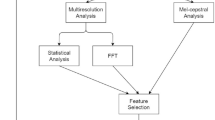Abstract
Objective
To examine whether vocal characteristics estimated by acoustic parameters were associated with phlegm, yin deficiency, or cold-heat patterns.
Methods
A total of 75 college students (males:females = 53:22) aged 19–24 years were enrolled in this study. Each subject was asked to complete the phlegm pattern questionnaire (PPQ), yin deficiency questionnaire (YDQ) and cold-heat questionnaire (CHQ). For the acoustic analysis, each subject was asked to produce a sustained vowel sound (/a/) for 3 s to be used to calculate acoustic parameters. Then, habitual fundamental frequency (F0), jitter, shimmer, F0tremor, mean F0, standard deviation of F0, maximum F0, minimum F0, normalized noise energy, harmonic-to-noise ratio, signal-to-noise ratio, amplitude tremor, and power ratio were calculated using the Dr. Speech software. Finally, four hierarchical regression models with pattern questionnaire scores as dependent variables were formed to examine which factors among acoustic parameters, sex, and age were predictive of those pattern scores.
Results
PPQ, YDQ, heat, and cold pattern scores all formed significant regression model equations and the adjusted R2 values were 0.281, 0.164, 0.156, and 0.170, respectively. There were aging effects in the PPQ and YDQ models (standardized β=0.199, 0.271, respectively). Vocal tremor-related F0 tremor and vocal ringing-related power ratio parameters were associated with PPQ and YDQ scores. Gender was directly predictive of PPQ and indirectly moderated the relationship between power ratio and YDQ score. Vocal pitchrelated habitual F0 and mean F0 were associated with heat and cold scores. These results indicate that the vocal qualities of phlegm- and yin deficiency-susceptible subjects tend to be ringing and less tremorous, and those of heat- and cold-susceptible subjects tend to be high-pitched.
Conclusion
Our study results suggest that vocal characteristics estimated by acoustic parameters are partially predictive of phlegm, yin deficiency, heat, and cold patterns. In terms of phlegm and yin deficiency patterns, there were direct or moderating effects of sex and age.
Similar content being viewed by others
References
World Health Organization, ed. WHO international standard terminologies on traditional medicine in the Western Pacific region. Manila: WHO Western Pacific Regional Office, 2007.
Zou J, Tian D, Cong L, Sun X, Wang Q, Wang C, eds. Diagnostics of traditional Chinese medicine: auscultation and olfaction. Shanghai: Shanghai University of Traditional Chinese Medicine, 1999:182–191.
De Felippe ACN, Grillo MH, Grechi TH. Standardization of acoustic measures for normal voice patterns. Braz J Otorhinolaryngol 2006;72:659–664.
Ferrand CT. Harmonics-to-noise ratio: an index of vocal aging. J Voice 2002;16:480–487.
Dehqan A, Ansari H, Bakhtiar M. Objective voice analysis of Iranian speakers with normal voices. J Voice 2010;24:161–167.
Pyo HY, Sim HS, Song YK, Yoon YS, Lee EK, Lim SE, et al. The acoustic study on the voices of Korean normal adults. Speech Sci 2002;9:179–192.
Pinczower R, Oates J. Vocal projection in actors: the longterm average spectral features that distinguish comfortable acting voice from voicing with maximal projection in male actors. J Voice 2005;19:440–453.
Smits I, Ceuppens P, De Bodt MS. A comparative study of acoustic voice measurements by means of Dr. Speech and Computerized Speech Lab. J Voice 2005;19:187–196.
Park CK, Lee SH, Park HJ, Baik YS, Park YB, Park YJ. Autonomic function, voice, and mood states. Clin Auton Res 2011;21:103–110.
Cho SW, Yin CS, Park YB, Park YJ. Differences in selfrated, perceived, and acoustic voice qualities between highand low-fatigue groups. J Voice 2011;25:544–552.
Petrovi -Laz M, Babac S, Vukovi M, Kosanovi R, Ivankovi Z. Acoustic voice analysis of patients with vocal fold polyp. J Voice 2011;25:94–97.
Dinicola V, Florella ML, Spinelli DA, Fiorella R. Acoustic analysis of voice in patients treated by reconstructive subtotal laryngectomy. Evaluation and critical review. Acta Othrhinolaryngol 2006;26:59–68.
Pribuisien R, Uloza V, Kupcinskas L, Jonaitis L. Perceptual and acoustic characteristics of voice changes in reflux laryngitis patients. J Voice 2006;20:128–136.
Doga M, Midi I, Yazici MA, Kocak I, Günal D, Sehitoglu MA. Objective and subjective evaluation of voice quality in multiple sclerosis. J Voice 2007;21:735–740.
Welham NV, Maclagan M. Vocal fatigue: current knowledge and future directions. J Voice 2003;17:21–30.
Protopapas A, Lieberman P. Fundamental frequency of phonation and perceived emotional stress. J Acoust Soc Am 1997;101:2267–2277.
Park YJ, Park JS, Kim MY, Park YB. Development of a valid and reliable phlegm pattern questionnaire. J Alt Comp Med 2011;17:851–858.
Lee S, Park J, Lee H, Kim K. Development and validation of yin-deficiency questionnaire. Am J Chin Med 2007;35:11–20.
Kim SK, Park YB. Development of questionnaires for cold-heat partternization. J Kor Inst Orient Med Diagn 2003;7:64–75.
Han SS, Lee SC, eds. Statistical analyses in the nursing and public health fields: regression analysis. Seoul: Hyun- Moon Press; 2004:323–359.
Tanaka Y, Nishio M, Niimi S. Vocal acoustic characteristics of patients with Parkinson’s disease. Folia Phoniatr Logop 2011; 63:223–230.
Lee BK, Park YB, Kim TH, eds. Textbook of Oriental medicine: listening examinations. Seoul: Sung Bo Sa, 1988:109–124.
Park YB, Kim TH, Park YJ, eds. Textbook of biofunctional medicine: clinical management. Seoul: Koon Ja Press; 2008:376–379.
Greeley HP, Berg J, Friets E, Wilson J. Fatigue estimation using voice analysis. Behav Res Methods 2007;39:610–619.
Author information
Authors and Affiliations
Corresponding author
Rights and permissions
About this article
Cite this article
Park, YJ., Park, YB. Relationships between pathological patterns and vocal qualities estimated by acoustic parameters. Chin. J. Integr. Med. 21, 346–354 (2015). https://doi.org/10.1007/s11655-015-2171-9
Received:
Published:
Issue Date:
DOI: https://doi.org/10.1007/s11655-015-2171-9




